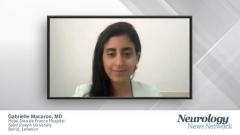
Relapse Following Discontinuation of Ozanimod
A multiple sclerosis expert, Dr Brownlee shares study design and clinical data on relapse following discontinuation of ozanimod in patients with multiple sclerosis.
Episodes in this series

Wallace Brownlee, MBChB, PhD, FRACP: At the recent European Academy of Neurology Congress meeting in Vienna, Austria, new data were presented on patients stopping treatment with ozanimod, in an abstract titled “Analysis of Multiple Sclerosis Relapse Following Discontinuation of Ozanimod in DAYBREAK.” Ozanimod is a sphingosine-1-phosphate, or S1P receptor modulator, that binds with high affinity to the S1P subtypes 1 and 5. It’s approved in many countries for the treatment of relapsing forms of MS [multiple sclerosis]. People with MS may be at risk of disease reactivation after stopping other S1P modulators, particularly fingolimod. That can lead to severe disease reactivation. The investigators of the DAYBREAK study wanted to look at people who discontinued ozanimod in the open-label extension of the pivotal phase 3 trials.
They analyzed the timing and severity of relapses in people who stopped treatment, and they focused particularly on the subset of women who discontinued ozanimod for family-planning reasons. Among the whole DAYBREAK study population, comprising nearly 2500 ozanimod-treated patients, 439 discontinued treatments, or about 17% of the overall cohort. As we see in clinical practice, there is a whole range of reasons given for treatment discontinuation. These included withdrawal from the study by patient choice, a lack of efficacy, adverse events, and family planning. The patients who stopped treatment were fairly typical of a relapsing MS population. They had a mean age of 35 years, and 70% were female. Overall, they had low levels of disability with mean EDSS [Expanded Disability Status Scale] scores of 2.7.
On average, they’d been treated with ozanimod for a little over 2 years. Overall, about 2.3% of patients who stopped treatment with ozanimod experienced a relapse after a median of 54 days. All the relapses that were seen were judged to be mild or moderate in severity by investigators. And 9 of 10 patients who experienced a relapse were treated with steroids. Thankfully, recovery was good overall in this group, and none of the patients had a severe persistent increase in disability as measured by EDSS scores.
The investigators looked at detail in the subgroup of women who stopped ozanimod for family-planning reasons, given this is such an important issue in everyday practice. Although women stopping treatment for family planning only accounted for 17% of patients discontinuing ozanimod, they were overrepresented in the number of people who experienced a relapse. Six of 10 patients who had a documented relapse were discontinuing because they had intended to start a family.
Just like in the whole trial population, for the patients who experienced a relapse after stopping for pregnancy, most relapses were mild and associated with a full recovery. Importantly, there were some differences in the women who discontinued ozanimod for family planning compared with the overall trial population. This may underpin the higher risk of relapse. These features included a younger age and lower levels of disability as measured by EDSS scores.
Transcript edited for clarity
Newsletter
Keep your finger on the pulse of neurology—subscribe to NeurologyLive for expert interviews, new data, and breakthrough treatment updates.
























